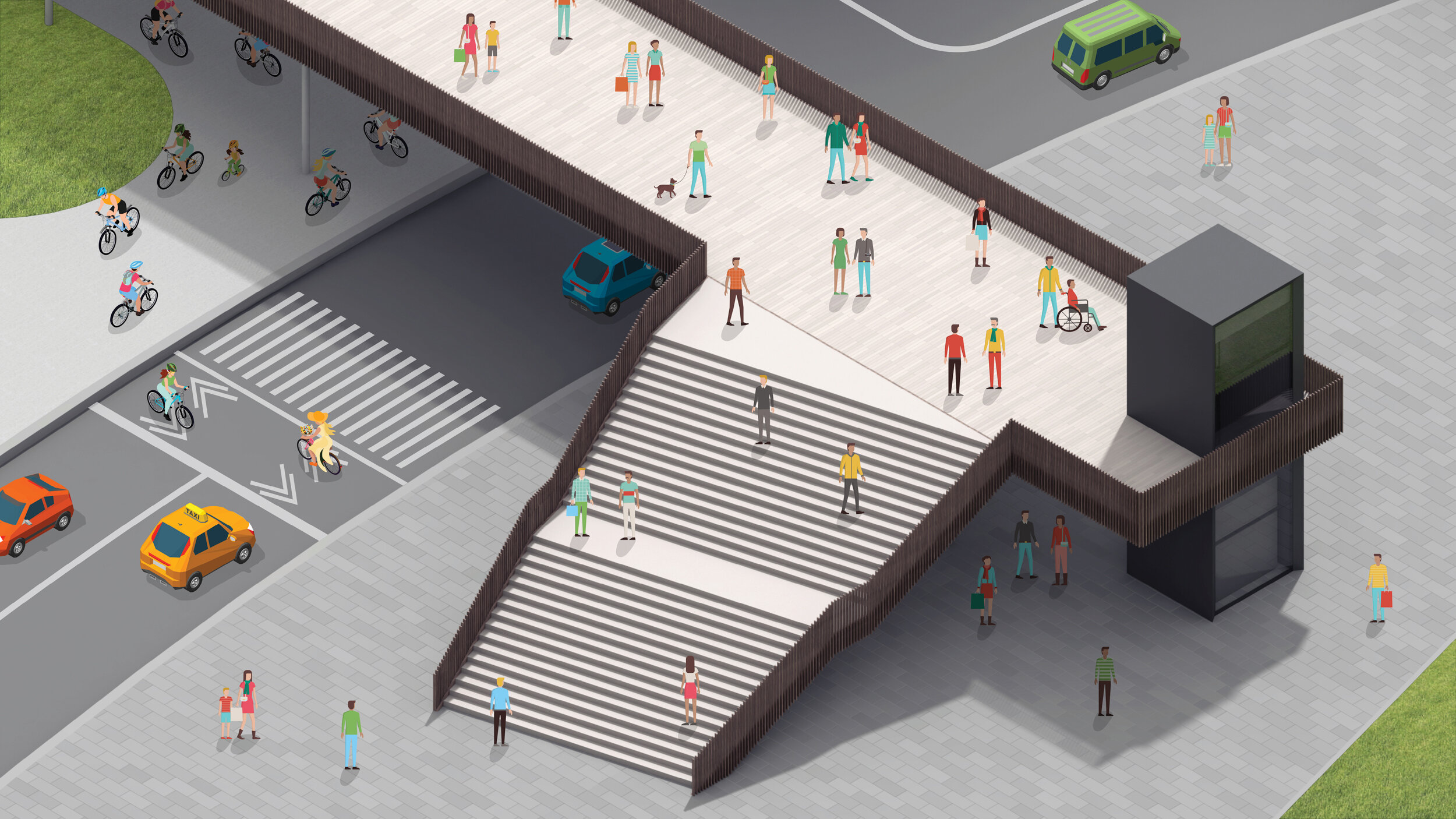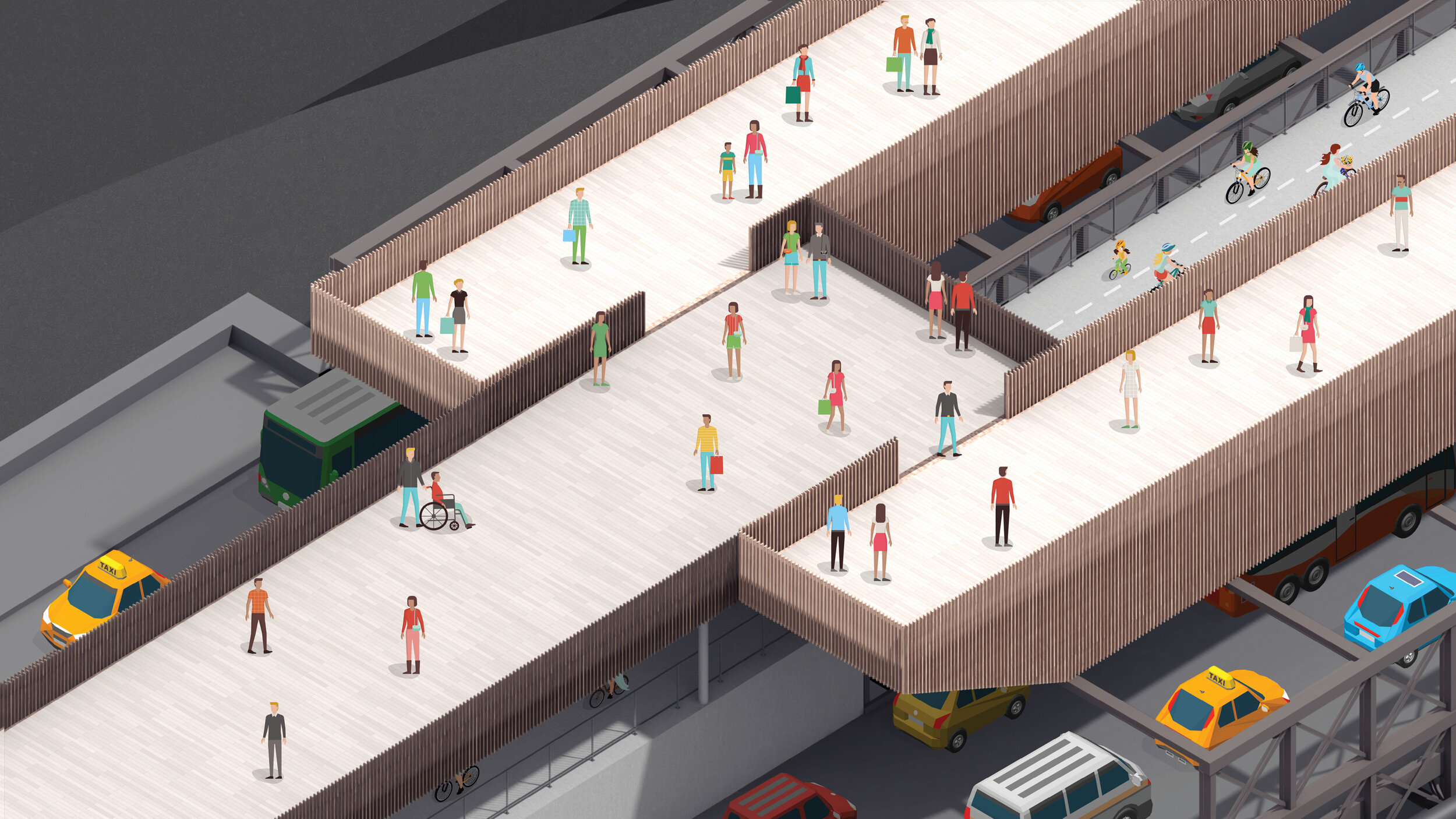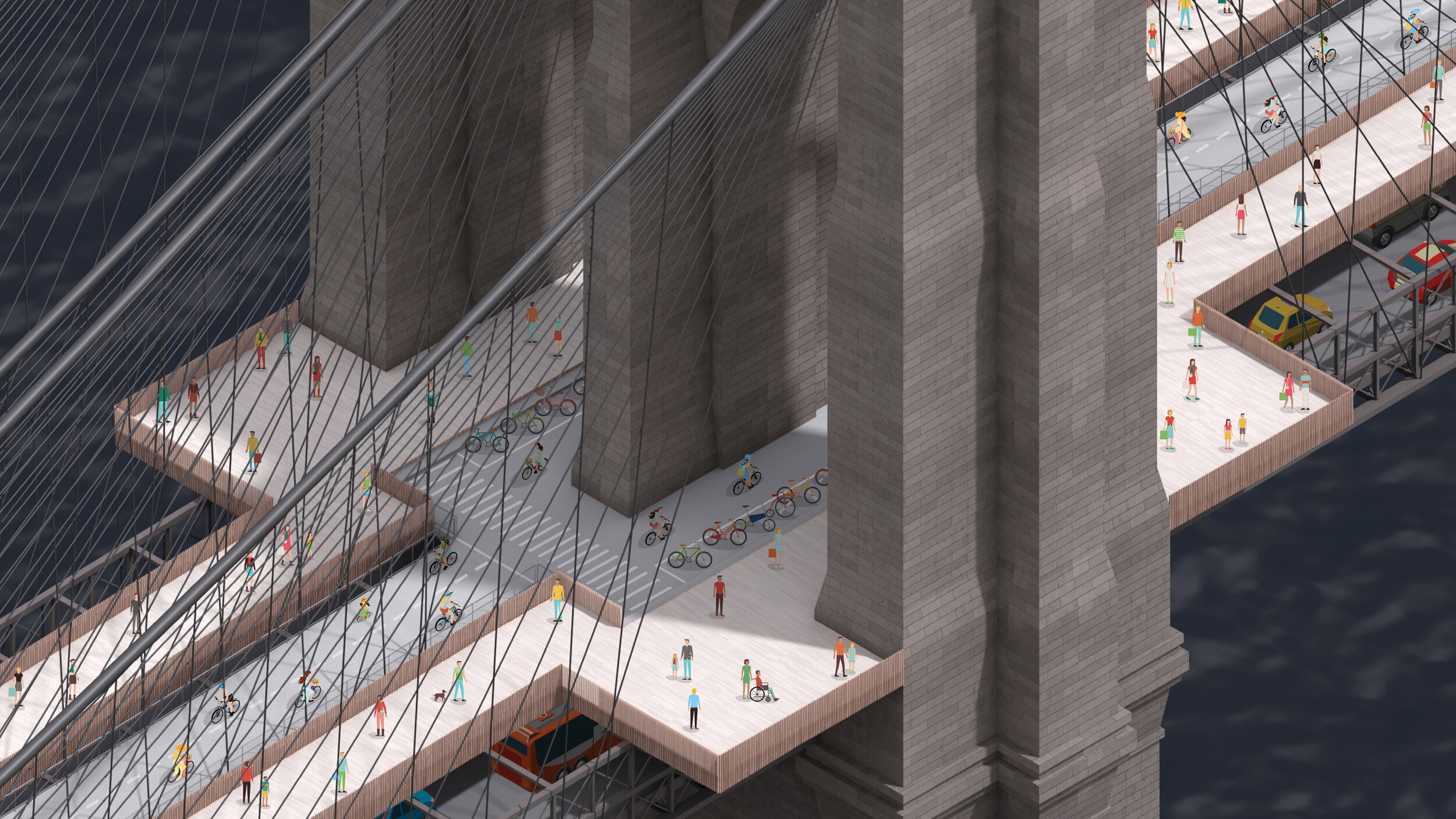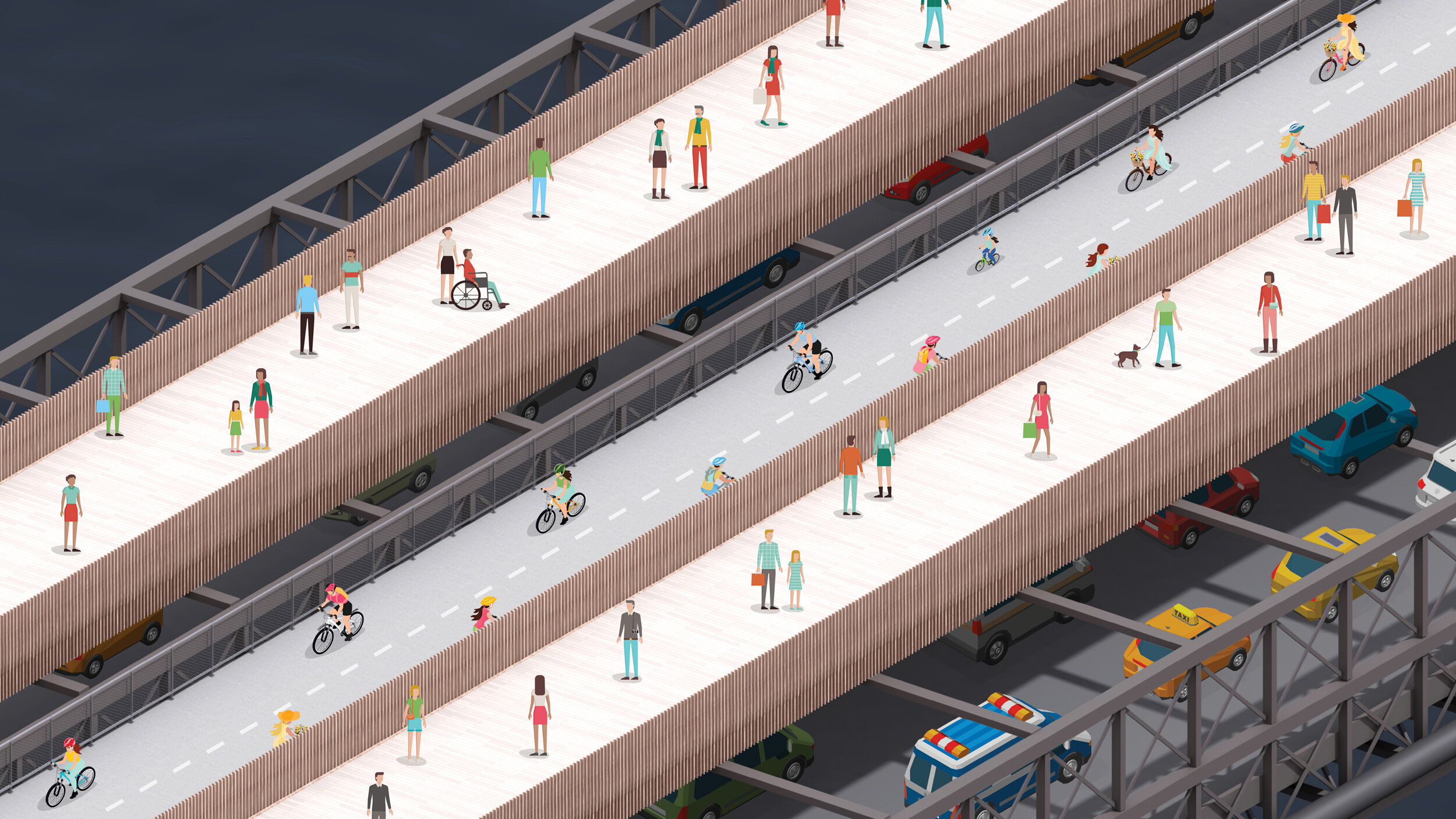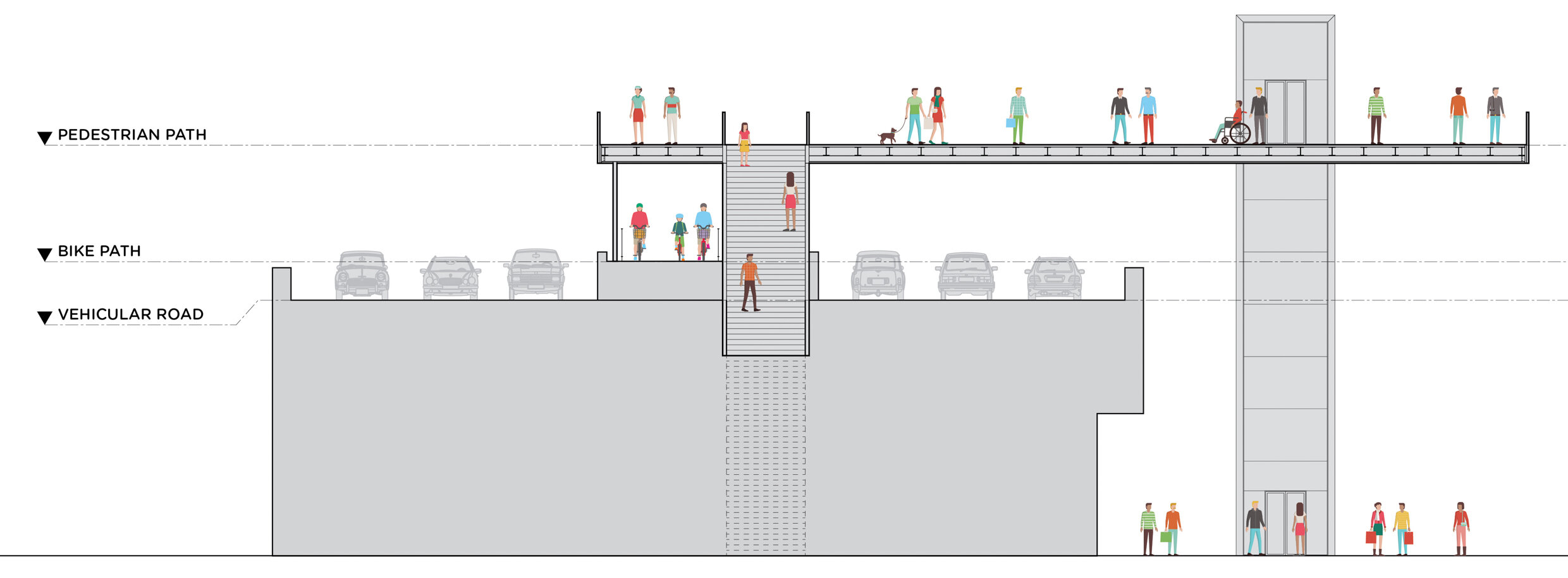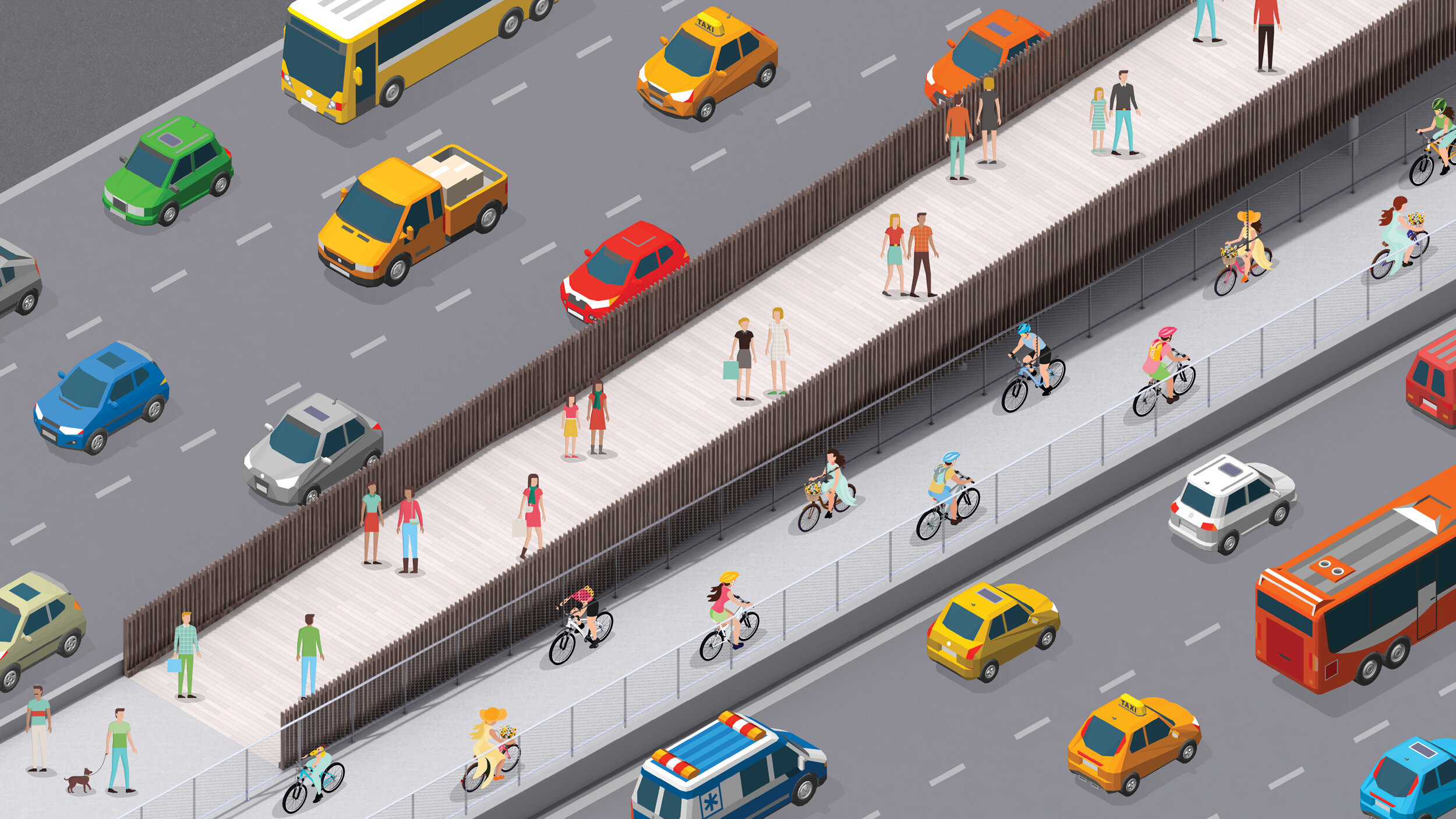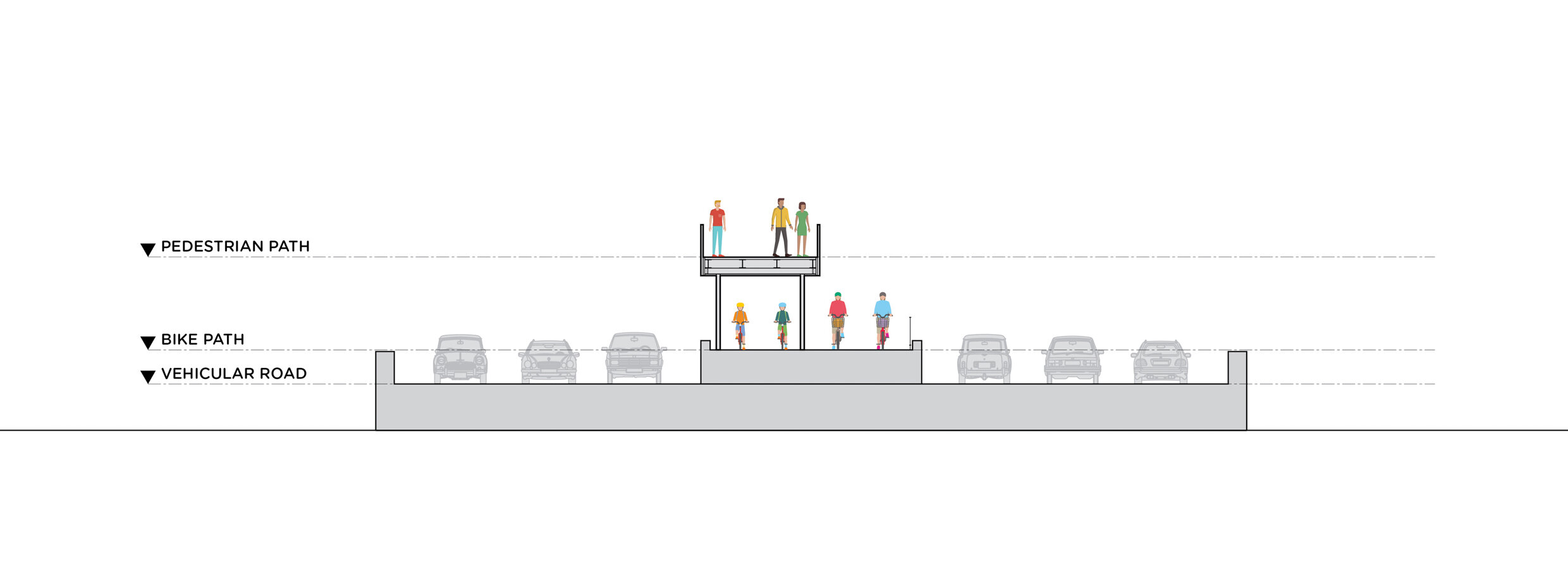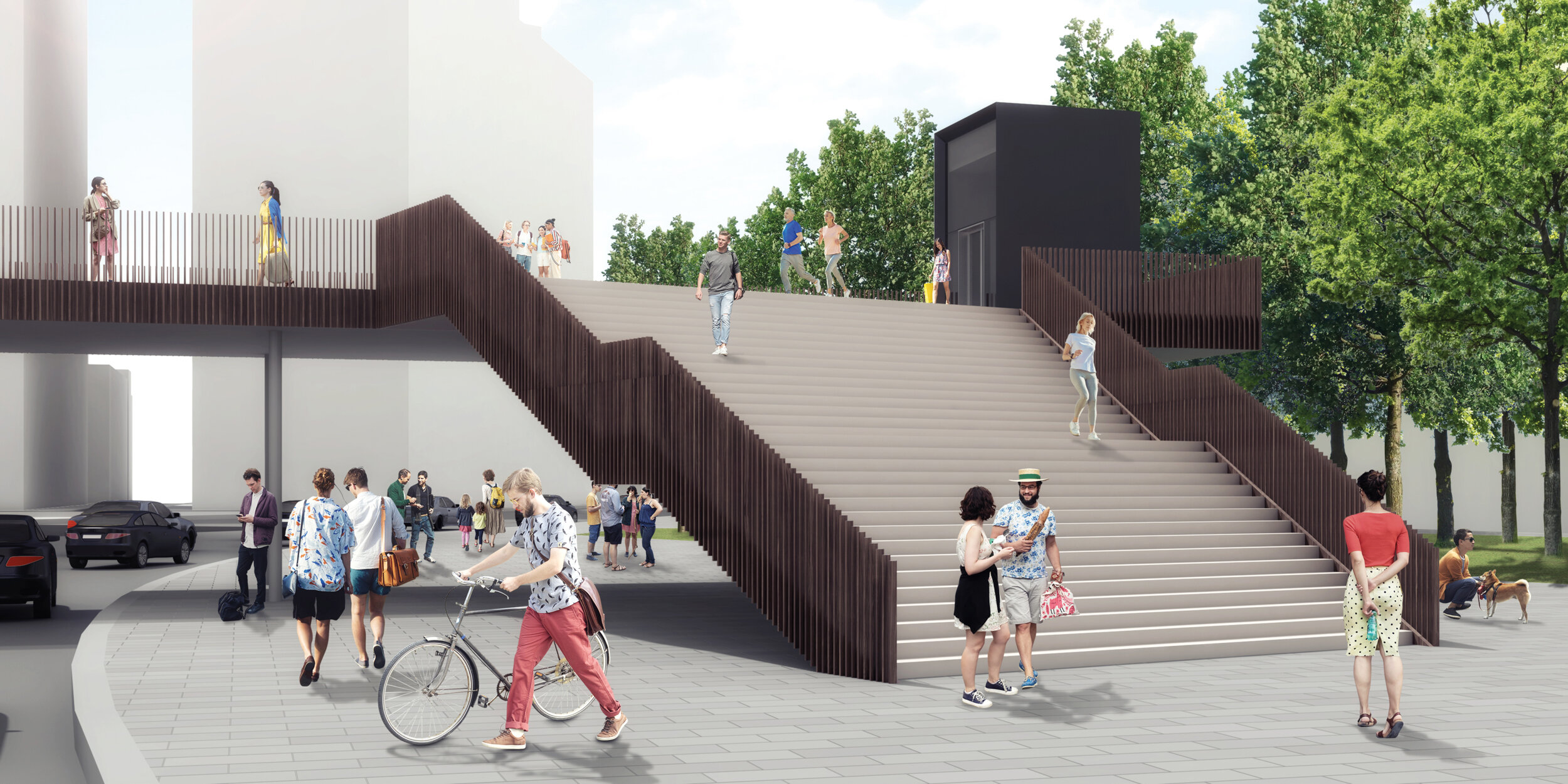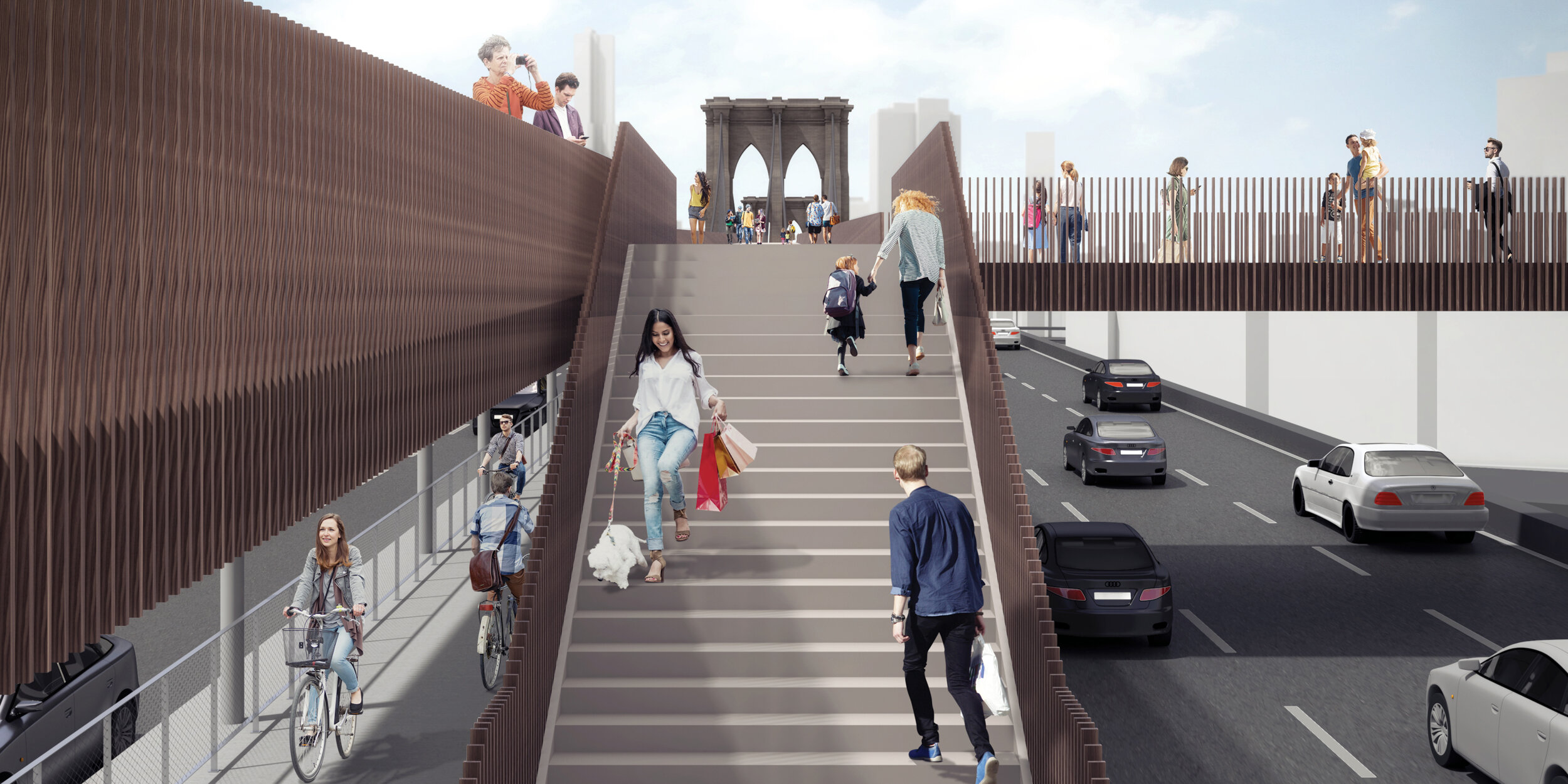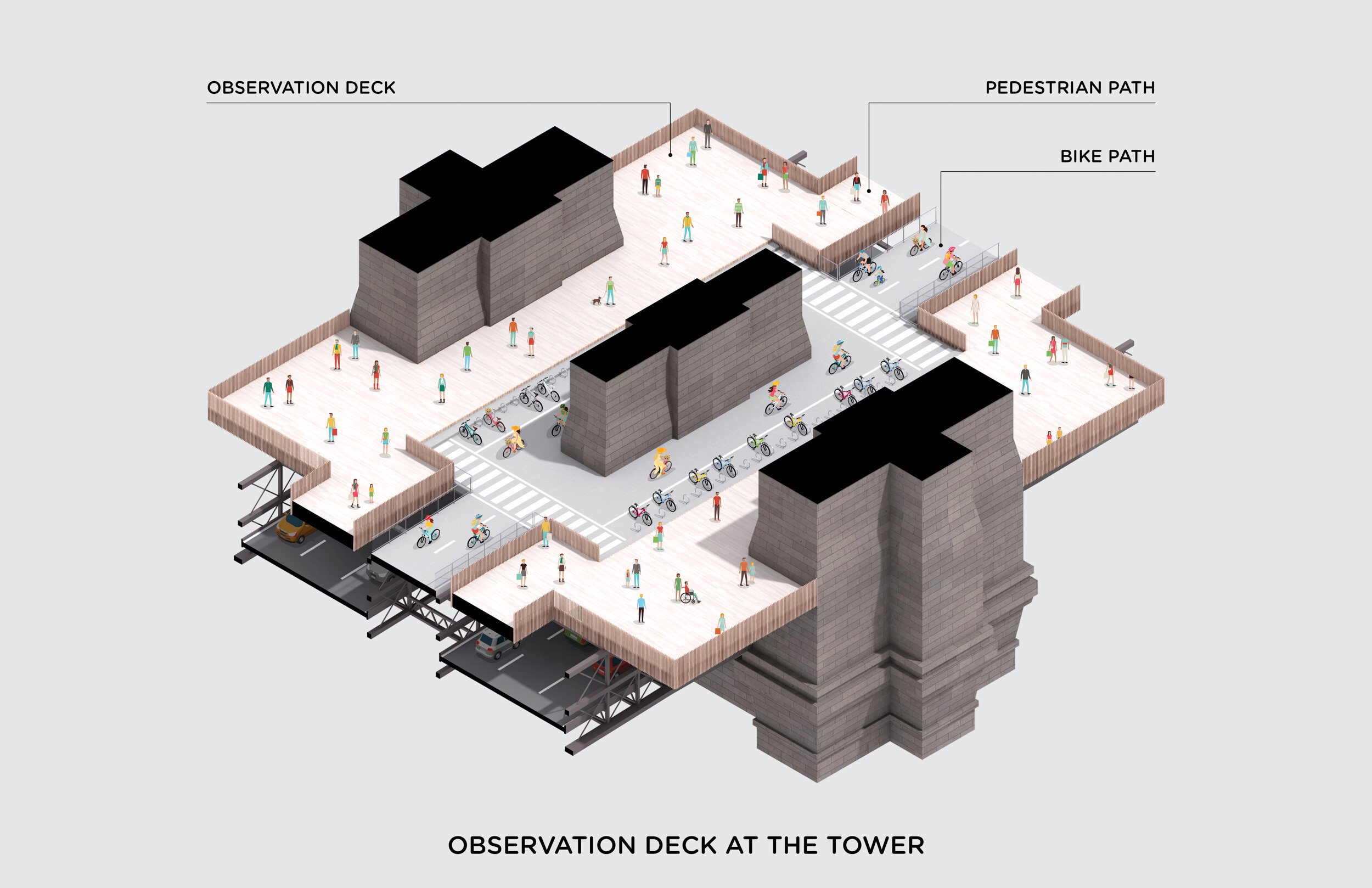What is the future of the Brooklyn Bridge? It can be a park with lots of trees, an event space, or a shopping street with lots of vendors for neighborhood and tourists. However, the identity of Brooklyn bridge is what connects Manhattan and Brooklyn. The “Brooklyn Bridge Strip” project respects the most important identity of the bridge and promote its functionality for all users.
The Brooklyn Bridge Strips vertically and horizontally separates the pedestrian path, the bike path and the vehicular path, so each user can enjoy the bridge at their own speed.
The bridge’s shared-use path for cyclists and pedestrians is always overcrowded and not comfortable for any users. The path is too narrow to accommodate both users, and the Brooklyn Bridge does not have a dedicated pedestrian path and bike path. In addition, the narrow entrances on both the Manhattan and Brooklyn sides are crowded, so it is not comfortable to approach the bridge. The current walkway needs to be widened and separated from higher-speed bike users for both pedestrians and bikers. “Brooklyn Bridge Strips” is the proposal to provide dedicated and wider entrances and paths for pedestrians and cyclists.
When Brooklyn Bridge opened to the public, there were three different lanes for horse-drawn wagons, streetcars, and pedestrians. Lanes were cleared separated by users. The bridge can hold users traveling at different speeds without interference as the bike traffic was not heavier than today. However, in the century since the bridge opened, the original pedestrian lane has become a shared-use path for both pedestrians and cyclists. As a transportation infrastructure, the bridge must be transformed to accommodate different traffics. The bridge’s major appearance and structure will remain the same as when it was opened, but the bridge needs to embrace changes to fulfill its role as an infrastructure. The bridge is not changing, but rather evolving with its original iconic feature.
The current pedestrian path is approximately 16 feet wide on average. Enhancing pedestrian and bike flows requires not only a wider pedestrian path and bike lane, but also wider dedicated entrances for each side of the bridge. The existing 16-foot-wide pedestrian path will also be used as the bike path, and multiple strips will be vertically layered or placed in parallel to provide dedicated paths for pedestrians and cyclists. At the entrance of the bridge, the pedestrian strip will overlay above the bike lane. The elevated pedestrian path and stairs will be located on the Manhattan side, and the pedestrian ramp and stairs will be extended from the ground level on the Brooklyn side. When the vertically overlaid strips meet at the bridge structure, the pedestrian strip will divide to both sides of the bridge and the bike strip will pass between the divided pedestrian strips. Cyclists can ride the bike strips without any interference from pedestrians, and pedestrians can walk and enjoy the bridge at their own speeds.
There are currently three uncomfortable moments on the Brooklyn Bridge: 1) the narrow entrance, 2) the narrow shared-use path, and 3) no observation area on the bridge. Due to congestion by pedestrians, cyclists, and illegal vendors, the bridge traffic is always stagnant. Illegal vendors must be restricted. 1) The elevated pedestrian path at each entrance provides a much wider entry and exit experience for pedestrians and cyclists and minimizes the risk of contact with vehicular traffic. Both pedestrians and cyclists are also completely separated from the beginning of the bridge. Elevators for the handicapped will be provided on both the Manhattan and Brooklyn sides. 2) The wide pedestrian path also provides a comfortable experience for all people who are walking, running, standing, and taking pictures. Cyclists will use the dedicated 2-lane bike path, which is currently used as a shared-use path. Cyclists can enjoy their ride without being crowded with pedestrians. 3) The Brooklyn Bridge is famous for tourists from all around the world. Many people enjoy taking pictures of the Manhattan and Brooklyn skylines. Four observation decks are proposed at the edge of the bridge and the tower. The observation deck at the tower will be used for both pedestrians and cyclists.
MANHATTAN ENTRANCE
The grand staircase invites people to the elevated pedestrian path, and an elevator is also provided for the handicapped. The City Hall park serves as the entrance plaza to the Brooklyn Bridge. The existing shared-use path will be converted to a dedicated bike path. The elevated pedestrian path will be 23 feet wide.
EDGE OF THE BRIDGE
The elevated pedestrian path will be divided at the edge of the bridge. Each divided path will be 15 feet wide. The bike path will continue to climb until reaching the same elevation of the pedestrian path at the tower.
OBSERVATION DECK AT THE TOWER
The tower is only place where the pedestrians and cyclists interact. Cyclists can park their bikes and enjoy views at the observation deck. The observation deck is cantilevered from the bridge structure to provide spacious space and unobstructed views of Manhattan and Brooklyn.
MIDDLE OF THE BRIDGE
The pedestrian paths are located along both sides of the bridge while the bike path will be located at the center. The pedestrian and bike paths will have elevation differences ranging from 1 feet (at the tower) to 16 feet (at the Manhattan entrance). Pedestrians and cyclists are connected visually, but completely separated physically.
DUMBO ENTRANCE
The entrance at Dumbo is an extension of the existing stairs. The existing stairs from the ground level will be extended to the level of the elevated pedestrian path. Pedestrians will not obstruct cyclists on the bike path. In addition, the elevator is located on Anchorage Plaza, which is a potential public market.
BROOKLYN BRIDGE BLVD. ENTRANCE
Brooklyn Bridge Blvd. is an important connection for all users approaching the Brooklyn Bridge from Brooklyn neighborhoods. The ramp is located on the current pedestrian path, and it links people to the elevated pedestrian path. The existing bike path is maintained and connected to the bike path on the Brooklyn Bridge.
ENTRANCE AT MANHATTAN
BIKE PATH
OBSERVATION DECK AT THE TOWER
ENTRANCE AT DUMBO





